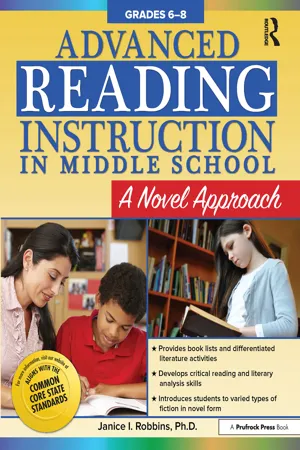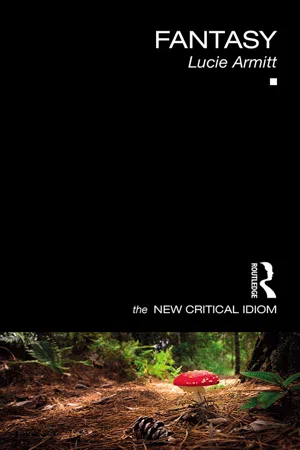Historical Fantasy Fiction
Historical fantasy fiction is a genre that combines elements of historical fiction with fantastical or supernatural elements. It often takes place in a specific historical period and incorporates magical or mythical elements into the narrative. This genre allows authors to explore historical events and settings while adding imaginative and speculative elements to create unique and engaging stories.
6 Key excerpts on "Historical Fantasy Fiction"
- eBook - ePub
Advanced Reading Instruction in Middle School
A Novel Approach (Grades 6-8)
- Janice I. Robbins(Author)
- 2021(Publication Date)
- Routledge(Publisher)
...You may choose to read a few sections of this novel and then contrast with brief passages from another fantasy novel that is of a different type, like one featuring kings, queens, and fairies. Modern fantasy novels often incorporate teenage characters as protagonists who assume the hero/heroine roles as opposed to the knights and princesses of fairy tales. Modern fantasy fiction writing generally incorporates these elements: + a story that could not actually happen in our known world, + a realistic setting on Earth and in contemporary times, + the use of magical powers or superhuman abilities, and + characters who are believable in the context of the fantasy. FANTASY NOVEL ELEMENTS The Setting The setting for fantasy novels is usually an imaginary world created just for the novel. It can, however, be a realistic world within which fantasy elements are introduced. The story frequently occurs in a medieval setting, characters have magical powers, and mythical beings often inhabit the setting of the story. Characters may start out in the real world but travel through some magical portal to a world beyond. Whatever the place and time, the setting remains a consistent backdrop for the unfolding story. The Characters Fantasy novels usually include some humans but also are home to gods and heroes, monsters and adventurers, wizards and witches, elves, fairies, gnomes, goblins, trolls, sprites, angels and devils, and other creatures that could not live in the known world. A fantasy novel may draw real-world characters into the fantasy setting or a world that appears to be just like the one they live in but, in fact, has odd, bizarre, and unreal characteristics. The characters in a fantasy novel are often magical creatures, archetypal figures inspired by folklore or myths. Characters may be animals or humans or things...
- eBook - ePub
Fantasy and Mimesis (Routledge Revivals)
Responses to Reality in Western Literature
- Kathryn Hume(Author)
- 2014(Publication Date)
- Routledge(Publisher)
...One such form is any mythic narrative so undisplaced that teller and audience believe absolutely in the accessibility of the fantastic phenomenon to anybody. It is doubtful if we have any such tales in literary form, but some religious narratives may qualify. Another exception is escapist literature which is unrealistic but not a departure from what could physically happen in this world. Stories in women’s magazines about ordinary girls marrying men who are brilliant, wealthy, fascinating, and besotted with them are sometimes called fantasy because of their raw daydream content, but they do not contravene the laws of physics or physiology. The third exception is simply what we normally call fiction. Plausible stories set in times past or present, which use invented characters in real or imagined situations, are not trying to depart from consensus reality, for all that they describe something which did not actually happen. If there had been a man like Horatio Hornblower during the Napoleonic wars, he might have enjoyed a career like that of C.S. Forester’s hero; most of the upper ranked characters in that enjoyable series are historical and do what the history books say they did, but Hornblower himself is fictional. However, if historical characters are made to depart substantially from historical fact, as is Nixon in Coover’s The Public Burning, then we are dealing with fantasy. If we turn to the diagram of texts and contexts with an inclusive definition in mind, we can compare some of its concerns with those of the exclusive theories, and also chart the subsequent concerns of this book: Figure 12 Since departure from consensus reality can only be registered from its appearance in the text, one might, at first, class this inclusive definition as work-oriented, but “consensus” immediately refers us both to the world of the author and that of the audience. Fantasy depends on what world-1 has conditioned the author to think of as real...
- eBook - ePub
- Jerome De Groot(Author)
- 2009(Publication Date)
- Routledge(Publisher)
...The historical novel enables this imaginative understanding. Like Manzoni and Lukács (Lukács 1962: 25), Butterfield understands the value of the historical novel as a means of furthering nationalism: ‘It is often born of a kind of patriotism; it can scarcely avoid always being the inspiration of it … the historical novel itself becomes a maker of history’ (Butterfield 1924: 42). Globally from Scott through to the late nineteenth-century novels of Polish writers Joseph Kraszowski and Henryk Sienkiewicz, from Chinua Achebe's Things Fall Apart (1959), from John Cowper Powys's Owen Glendower (1940) to Yukio Mishima's Sea of Fertility tetralogy (1966–71), one of the major elements of the historical novel has been as an expression of national character and self-definition. Daniel McGarry and Sarah Harriman White's World Historical Fiction Guide (1973) saw their audience as the educational community: ‘This work is designed especially for use by adults and by students in senior high schools, colleges and universities; but books suitable for junior high school students as well as adult readers are also included’ (McGarry and Harriman White 1973: iii). They list 6,455 novels from Antiquity onwards across the world, and define the genre as something both interested in the past but also incorporating an element of literary quality: ‘fiction is historical if it includes reference to customs, conditions, identifiable persons, or events in the past … among factors considered are literary excellence, readability, and historical value’ (McGarry and Harriman White, 1973: iv). Other bibliographies included those by Hannah Logasa (for children and young adults, 1927), James R. Kaye (1920), Ernest F. Leisy (American novels, 1950) and A. T. Dickinson (American novels, 1971). The most recent of these guides, Sarah Johnson's Historical Fiction: A Guide to the Genre (2005), which covers 1995–2004, runs for 830 pages and 3,800 entries...
...All these texts and narratives deal in the juxtaposition of competing worlds, wherein one world, purportedly representing ‘reality’, is left behind in preference for another which is unknown and ‘foreign’ in the sense of being strange, fabulous or grotesque. The laws of physics, logic, time, physiognomy, life and death and/or geography are usually subverted in preference for a narrative vision which is improbable, impossible, or beyond belief. As David Butler argues, the urge for fantasy is at the heart of all speculation as well as ‘every time we ask the question “what if?”, irrespective of whether the question is followed by the statement “dragons roamed the air”, “we could land on the moon”, “poverty was eliminated”, or “a cure for cancer was found”’ (Butler 2009: 4). James Walters makes a similar point when he argues that ‘fantasy is just as likely to emerge in a crime thriller about an escaped convict as it is in a story about a mythical kingdom in which the destinies of all creatures are decided by the fate of a magical ring.’ Again, Walters observes, ‘To take The Wizard of Oz … as an example, we might want to question whether it is a children’s film, fantasy film or musical, but we must also anticipate that a reasonable answer to such an enquiry would be “yes”’ (Walters 2011: 2, 74). To move from scope to type, several sub-genres always coalesce around fantasy and examples of all the following will be found in this volume: the fairy story, quest myth, fable, epic fantasy, nonsense narrative, sword and sorcery, talking animal fantasy, political fantasy including the utopia and dystopia, and erotic fantasy, upon which Chapter 6 is based...
- eBook - ePub
Reading Between the Lines
A Christian Guide to Literature
- Gene Edward Veith Jr.(Author)
- 2013(Publication Date)
- Crossway(Publisher)
...E I G H T FANTASY: Literature as a Lamp J ust as there is a literature of imitation, there is a literature of creation. Fairy tales, allegorical visions, beast fables, medieval romances, Gothic tales, supernatural thrillers, epic quests in a sub-created uni verse, and science fiction constitute an important literary tradition. Such works have always been popular, firing the imaginations of their readers with tales of wonder and mystery that transcend everyday life. Fantasy draws upon the inward imagination rather than external reality for its subject matter. The play of the creative imagination is an important human power. The pure, radical fictionality of fantasy—its separateness from what we already experience—is part of its value. Nevertheless, the lamp of fantasy can shed light on the world outside its pages. Christians have always been drawn to fantasy. The great pioneers of fantasy—Spenser, Bunyan, Swift, MacDonald, Tolkien, Lewis were all devout Christians, as are many authors and avid readers of fantasy today. On the other hand, some Christians decry unrealistic lit erature. Mythological tales of magic spells and demonic villains seem to them dangerously close to the occult. Yet even the critics of fantasy can hardly deny that in the hands of a John Bunyan or a C. S. Lewis, fantasy has been a way of exploring and proclaiming the Christian faith. Fantasy, by projecting the inner life and by symbolizing the intan gible, will by its very nature raise spiritual issues. The battle between good and evil, the inner struggles of the mind, the contest between God and Satan for the soul—such momentous truths are in the realm of the unseen, but fantasy can express them in symbolic form. Something spiritual may be evil or it may be good. Fantasy’s spiritual orientation means that it can embody the occult and promote immorality, or it can embody Christianity and promote virtue...
- eBook - ePub
- Jacqueline Furby, Claire Hines(Authors)
- 2011(Publication Date)
- Routledge(Publisher)
...The act of telling one another stories has as its heritage the magical mythic tales, folklore and legends that people have exchanged all over the world, both before and since the first recorded Sumerian (roughly presentday Iraq) fantasy The Epic of Gilgamesh from the second millennium BCE (Before the Current Era). The ancestral roots of contemporary fantasy film can therefore be traced back to earlier forms of fictional storytelling such as the novel, short story, epic and lyric poetry, literary fairy tale, romance, oral folktale, myth, and legend. Though fantasy film may differ in some ways from these literary and non-literary forms, it is evident that they share many things in common including themes, characters, archetypes, subjects, structure, plot lines and stories. Obvious examples of stories that constitute part of what John Clute and John Grant, in their exhaustive encyclopaedia of fantasy, call ‘the ocean that is the literature of the fantastic’ (1997: vii), include many varieties of English literature now adapted for film. For instance, J.R.R. Tolkien’s hugely influential high fantasy novels The Lord of the Rings (1954–5) and The Hobbit (1937), which heralded a resurgence of fantasy in England, and C.S. Lewis’s The Chronicles of Narnia, from The Lion, the Witch and the Wardrobe (1950) to The Last Battle (1956). The publication of The Lord of the Rings changed the face of the literary fantasy world and ignited the imagination of generations of devoted readers. In The Lord of the Rings: The Mythology of Power, Jane Chance writes that what partly accounts for the success of Tolkien’s masterpiece is that it offered a ‘twentieth-century understanding of the nature of good and evil, the value of community, the natural order of the universe, and the singularity of the individual’ (2001: 1)...





